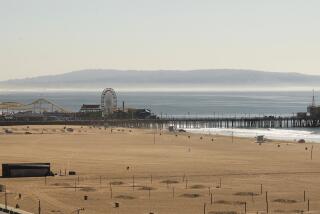Santa Monica officials sue FAA to gain control of cityâs airport
In the wake of Septemberâs deadly jet crash, Santa Monica officials sued the Federal Aviation Administration on Thursday to gain control of the cityâs embattled airport, which local groups want to turn into a park.
Filed in U.S. District Court in downtown Los Angeles, the lawsuit seeks a declaration that the city holds clear title to the 227 acres containing the oldest continuously operating airport in the county.
It also challenges the constitutionality of a 1948 agreement between the city and federal authorities that requires the historic property and its 5,000-foot runway to remain an airport in perpetuity or be returned at the option of the FAA to the U.S. government.
If the city is successful, there is concern among aviation organizations that it might alter the status of former military airports around the nation and encourage attempts to close some of them.
During World War II, the Defense Department took over Santa Monica Municipal Airport and improved its runway, taxiways and other facilities for military purposes and aircraft production. It returned the airfield to the city under terms to preserve its use.
Santa Monica officials and airport opponents contend the obligation to operate the airport ends in 2015, according to various agreements and a 1984 court settlement with the federal government.
âWe need to get these legal questions answered. The community expects us to protect their health, safety and welfare,â said Santa Monica Mayor Pam OâConnor, making note of the private jet that veered off the runway Sept. 29 and smashed into a hangar, killing four people.
OâConnor added that city officials want to determine whether they fully control the airport so they can make decisions next year about its future, including the possibility of turning it into a park.
âIâm encouraged that Mayor OâConnor included protecting community health,â said Martin Rubin, an anti-airport activist who lives near the popular facility. âIt is a huge part of the equation, and the federal government needs to be accountable with regard to the health of airport neighbors.â
FAA officials declined to comment, saying that as a matter of policy they do not discuss pending litigation.
The agencyâs long-held position is that the city must operate the airport through 2023 under assurances it gave in exchange for federal airport improvement grants.
The FAA also has asserted that Santa Monica is further obligated to keep the airport open well beyond 2023 because it acquired the much improved airfield after World War II under terms of the federal Surplus Property Act.
FAA officials have said in the past that they are committed to preserving the federal investment and keeping the airport open.
The lawsuit, like the cityâs constant attempts to close the airport or restrict its operations, is expected to attract the attention of the local aviation community and national organizations such as the Aircraft Owners and Pilots Assn. and the National Business Aviation Assn.
âIt is abundantly clear that the claims made in the cityâs lawsuit have no basis in fact,â said Ken Mead, general counsel for the pilots association. âThe cityâs argument is hardly a novel one, and it should be very clear by now to members of the Santa Monica City Council and opponents of the airport that the airport must remain in operation under its agreement with the federal government.â
If the court overturns Santa Monicaâs 1948 transfer documents, it might open the door to efforts to close or re-purpose other airports around the country that were returned to local governments after World War II. According to the pilots association, there are at least 203 such airfields.
Over the years, attempts by Santa Monica to shut down the airport and curtail jet operations have not been successful in court. In the latest effort to ban jets with fast landing speeds, a federal appeals court ruled against the city in 2011, concluding that the prohibition illegally discriminated against aircraft types.
Times staff writer Martha Groves contributed to this report.
More to Read
Sign up for Essential California
The most important California stories and recommendations in your inbox every morning.
You may occasionally receive promotional content from the Los Angeles Times.











